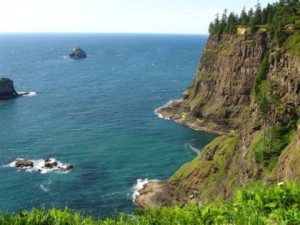
29 Feb 2012
By Rachel Nuwer, from the Mission Blue website

The three marine reserves—off Cape Perpetua, Cape Falcon, and Cascade Head—will extend three miles from the Oregon coast into the Pacific Ocean, encompassing some 109 square miles, or around 70,000 acres. Prior to the decision, Oregon had just two small pilot protected areas of about 9 square miles that went into full protection earlier this year. With the new additions, around 10 percent of Oregon’s territorial sea will be protected.
“The Governor is very pleased,” said Richard Whitman, Governor John Kitzhaber’s natural resources advisor. “We now have in place the network needed to test out this concept in Oregon,” he said. “We’ll see what the biological and economic effects of the system will be over the next ten years.”
The legislation calls for protected no-take marine reserves (about 3.4 percent) surrounded by buffers of marine protected areas (6 percent). The latter will allow for fishing of species like Dungeness crab and salmon, but trawling, harvesting forage fish, and offshore development will still be prohibited.
“We’re seeing a lot of signs of stress in the marine ecosystem off the Oregon coast,” said Ben Enticknap, the Pacific project manager for the non-governmental organization Oceana, a member of the Mission Blue coalition. “This is a chance to help build an understanding of what it means to have places untouched by human impacts.”
Enticknap has worked on the issue for over six years. He and his colleagues at Oceana identified and mapped Oregon’s important ecological areas and spoke to local communities to garner support. Along with a number of other organizations, Oceana has been “one of the main groups trying to work to advance this concept,” Whitman said, and added that Oregon’s Ocean Policy Advisory Council ultimately recommended the reserves in their current form.
Conservationists hope the marine reserves will help ailing species. Scientists catalogued 32 threatened and endangered species and populations that feed and migrate off the Oregon coast, such as salmon, smelt, humpback whales, and seabirds like the marbled murrelet. Oregon’s waters are home to three overfished species, including the slow-growing yelloweye rockfish, which lives to be over 100 years old. Under current management plans, the yelloweye rockfish population isn’t projected to recover fully until 2084.
Enticknap acknowledged that Oregon’s protected areas won’t be spared the impacts of climate change and ocean acidification, but he hopes that the networks can act as a kind of buffer, increasing the resilience of ecological communities impacted by those broad scale, global changes.
Around the world, no-take marine reserves typically increase the size of local marine life and also result in increased fish stocks. Marine animals nurtured in reserves spill over into adjacent areas, making the entire near-shore ecosystem more healthy and productive. This benefits the environment as well coastal communities who rely on the ocean economically.
Some fishermen are worried that the reserves will impact their livelihoods, though Enticknap pointed out that the 57-2 vote indicates that the “vast majority” of representatives and senators are in favor of the system. “There’s always going to be a vocal minority opposed to conservation,” he said, “but the majority of citizens, local businesses, and even fishermen support this and think it’s the right way to go.”
Whitman added that input from a broad range of stakeholders—from fishermen to recreational users—were considered in designing the reserves and protected areas.
Protections won’t go into effect immediately. The legislation calls for a two-year hiatus during which U.S. Fish and Wildlife Service scientists gather baseline data, funded by a $1.6 million dollar lottery grant. Over two summer field seasons, the scientists will collect data from all three future marine reserve sites, plus some control sites outside of those areas. In the meantime, fishermen can continue with business as usual.
People are happy with the outcome, Enticknap said, though conservationists recognize that the State’s southern coast still lacks protection. Last summer, Oceana conducted surveys of the area’s biodiversity with a remotely operated vehicle, observing corals, sponges and rockfish. Though Enticknap hopes to eventually establish a network of protected areas encompassing the full Oregon coast, he said that, for now, no imminent plans exist to make this goal a reality.
“Oregon values process as much as outcome, that’s a big thing I learned while working on this,” Enticknap said, adding that it’s been a challenge bringing so many people together to support the legislation. “We think the current network is a little thin, but it is going to protect marine habitats and biodiversity,” he said.
The Governor is “absolutely” planning to sign the bill, Whitman said, which should happen soon.